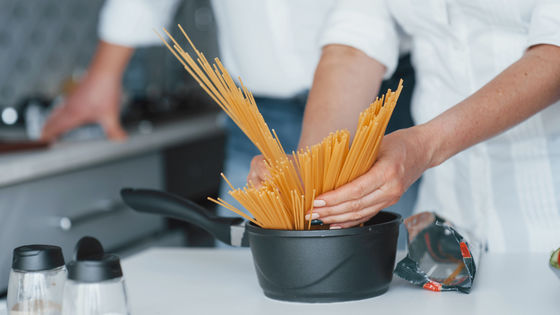What are the results of a study using particle accelerators and neutron experiments to find the best pasta boiling time and salt content?

To make delicious pasta, it is important to use the right amount of water, cooking time, and salt. To explore the optimal cooking method through physics, a research team from Lund University published the results of analyzing the internal structure of pasta using X-rays obtained from a circular particle accelerator facility.
A small-angle scattering structural characterization of regular versus gluten-free spaghetti - ScienceDirect
How to cook the perfect pasta – we used particle accelerators and reactors to discover the key
https://theconversation.com/how-to-cook-the-perfect-pasta-we-used-particle-accelerators-and-reactors-to-discover-the-key-268416

To investigate the nano- and microstructure of regular wheat gluten-containing spaghetti (regular pasta) and gluten-free spaghetti (GF pasta), a research team led by Andrea Scotti, senior lecturer in physical chemistry at Lund University, used the UK's national synchrotron (circular particle accelerator) facility, Diamond Light Source , to study low-angle X-ray scattering of pasta. Furthermore, they visited the UK's ISIS Neutron and Muon Source , a neutron research facility, and the French Institut Laue-Langevin , a neutron research facility, to use neutrons to reveal the microstructure of regular and GF pasta under different cooking conditions.
In addition to comparing regular pasta with GF pasta, the researchers also analyzed the structure of pasta under various conditions, such as boiling time and salt content, and attempted to discover the optimal boiling time and salt content by capturing the changes in the structure.

The analysis revealed that in regular pasta, gluten forms a 'thread-like network,' and when the starch swells and changes shape by absorbing liquid when heated, the gluten network envelops the starch, preventing it from collapsing. However, GF pasta lacks this gluten network, and the starch swells excessively and disperses easily, making it sensitive to cooking time and salt content and prone to crumbling.

Furthermore, it was found that the salt in the cooking water not only improves the taste of pasta, but also has a significant effect on the pasta's microstructure. When regular pasta is boiled in salted water, the gluten structure is maintained and the starch granules deteriorate less during the cooking process. However, when the salt concentration is doubled, the internal structure breaks down more rapidly and the starch granule structure changes significantly during the cooking process.
From the results of a detailed compositional analysis, the researchers concluded the following about the amount of salt needed to maintain the pasta's microstructure, and the appropriate boiling times for regular and GF pasta. The pasta used in this study was commercially available from supermarkets, with a diameter of approximately 1.67 mm.
The optimum salt concentration is 7 grams per liter of water.
・Boiling time is 10 minutes for regular pasta and 11 minutes for GF pasta
・GF pasta is structurally more fragile than regular pasta, so if you boil it for a longer time or increase the salt concentration, it will deteriorate more quickly.
Commenting on the research, Scotti said: 'Neutron scattering has played a fundamental role in improving our understanding of magnetic materials, batteries, polymers and proteins, and now it is helping to explain how everyday foods behave at a microscopic level. This shows how cutting-edge experimental tools, primarily used for fundamental research, are transforming food research. This study is a first step in characterizing the structure of commercial pasta and advances classical models that have been used to derive information on the relationship between pasta microstructure and digestibility.'
Related Posts:
in Free Member, Science, Food, Posted by log1e_dh







